by tmoffett | Jan 7, 2014 | Color, Landscape, Photographic Philosophy, Photographic Technique
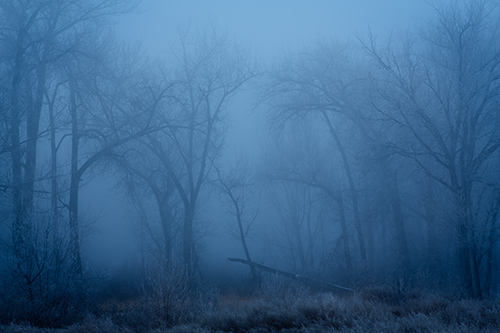
Into The Unknown
Photography has been a major part of my life for many years. I started shooting snapshots with a toy camera when only seven or eight years old. I graduated to a Kodak Instamatic 110 when I was about ten. I remember fighting back tears when I was told that the Community Education photography class I had registered for shortly after receiving the Kodak camera had been canceled. I was only ten and knew nothing more than how to take snapshots, but I realized that there was more to be discovered. I settled for what that little camera could deliver until high school, when I purchased my first SLR, a Pentax ME Super. I promptly registered for a photography class and was hooked.
Over the years, through both formal education and experience, I have learned that photography can be a meaningful art form. Powerful messages can be delivered and personal feelings can be shared. However, just because photography can do these things, doesn’t mean it always does. Techniques must first be practiced and mastered and personal vision developed so that thoughts and feelings can be successfully rendered in the final image. I constantly stress to my students that technique must be mastered to the point that they no longer have to think about it, it just happens. Then, and only then will they be able to really let their feelings flow into their images.
One cold morning last week I was out by the lake in the dense fog. I was all alone, walking a path I had been on many times before, but this time it was different. At -8°C and all alone in a sea of fog, an eeriness that is hard to describe enveloped me. As I strained to see through the fog, a scene that many times would have appear to me in lighter tones and more neutral in color, appeared instead in darker tones and cold shades of blue. I could barely make out a few warmer shades of color in the brush in the foreground. My feelings were changing the way I viewed the world. The process of photographing the scene before me now became just a formality. The vision of the finished image was already there! Thought, feeling, technique and vision all worked in unison to create a photograph that described how I was feeling better than any words, or at least my words, could.
by tmoffett | Sep 3, 2012 | Color, Landscape, Photographic Technique
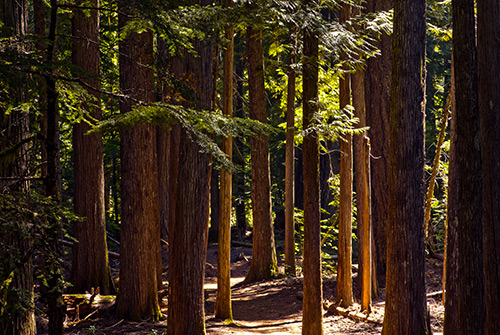
Trail to Proxy Falls
Another trip to photograph on the Oregon Coast is on the horizon, and I am sitting at my computer reviewing some of the images from my trip last month. The image above was actually taken on my way home. We drove the McKenzie Highway for the first time last month, as it has always been closed on my other return trips. It is a very interesting drive, and if taken early morning or late evening I can imagine some spectacular photographs could be made. Photography is all about the light, and in the middle of the day in most places, the light is not ideal.
One stop that we made in the morning was at Proxy Falls. We arrived at the lower falls just before the sun made its way over the ridge, giving us great light for about thirty minutes. I did make some great images, which will be posted another day, but what I want to discuss today is the image above. As Christeena and I made our way from the lower falls to the upper falls, we hiked through this small area of thick trees, and the light seemed to be bouncing around and reflecting off trees and rocks in such a way as to create this nice golden color, something that I don’t see very often. Just a few minutes later and the angle of the light would be too high to create this look. It would become harsh and unattractive. Learning to recognize the subtle changes in light quality is a must for a successful photographer. Once able to recognize, we must then master our equipment so as to be able to capture the quality of light in our photographs. Often I will be set up beside other photographers who I notice have cameras set on auto and then bracket their exposures like crazy, hoping to get the image that they see in their minds eye. I, on the other hand, take my time, feeling the scene, setting the camera and making just a few exposures, knowing that I have what I need.
Light is what we work with. Light strikes a subject and bounces back to my lens and is focused on the camera sensor. Understanding the properties and physics of light cannot be over-emphasized. Without that knowledge, I never would have recognized what was happening on the hike to Proxy Falls, let alone know how to capture it. Due to the high contrast in the scene, this was a very difficult photograph to make. Sure, I could have just settled for what the camera thought would be good, but then the shadows would have been so dark that the nice detail in them would be lost. Rendered any brighter and the highlights would be so overpowering that the rich golden glow would become lost. Only a perfect exposure would capture what I needed in the file to make the perfect print. And perfect is what I got!
by tmoffett | Aug 21, 2012 | Color, Landscape, Photographic Philosophy, Photographic Technique, Uncategorized
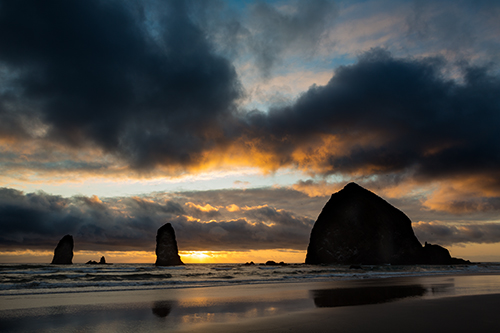
Haystack Rock and The Needles
Recently I was on the Oregon Coast, hoping to photograph some great skies over the ocean. On most of my trips to the coast I have encountered a great deal of fog, which is interesting, but I was looking for something different. Several evenings looked very promising, and then at the last minute fizzled out. On this particular evening, we had a wonderful sunset, for about 2 minutes, and then the sun dropped below the marine layer and all of the color disappeared. I worked hard and fast to position myself to capture this scene, and it made the entire trip worthwhile!
As is so often the case, the light changed so rapidly that I was very thankful to understand the technical side of photography. If I had been relying on the camera to make all of my decisions, I highly doubt that I would have been successful here. With such a high contrast scene, maintaining detail in both shadows and highlights and keeping good saturation in the color is not an easy task. Some would say to shoot several exposures and layer them, or shoot for HDR. Why, when it can be done, in my opinion, better in a single image? I have been and always will be a fan of getting it right in camera. It makes the printing process so much simpler and usually cleaner and sharper.
To really understand photography to the point of creating what my minds eye sees, and doing so almost without thinking has taken a lot of study, practice, mistakes, evaluation, more mistakes, and on and on. All of that time and effort has paid off for me many times over. One of the hardest things to convince my students of is that it is OK to make mistakes. That is how we learn. I still, after 30 plus years of practice, make mistakes. The difference, though, is that I evaluate them and learn from them. They make be better!
by tmoffett | Aug 14, 2012 | Color, Landscape, Photographic Philosophy, Ramblings
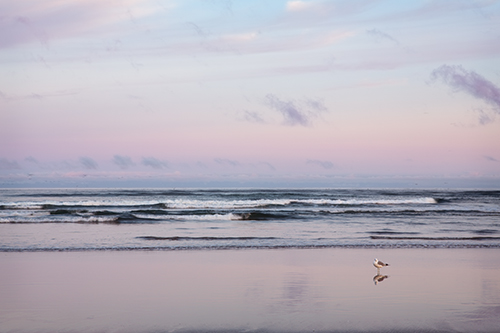
Lone Gull, Seaside,Oregon
Everyone thinks that the life of a photographer is a dream job. I do love my life and think this is a great job, but I must say it is more difficult (but rewarding!) than most think it to be. I just returned from a photography trip to the Oregon Coast, and I feel like I need a week to recover. While I did get to spend a lot of time doing what I love and visiting some of the greatest places on this planet, the schedule was brutal. It was so exhausting that I didn’t even get on the computer to blog, and I love blogging!
A normal day started at 4:30 or 5:00 in the morning. I would get up, get dressed and head out to a predetermined location. I would arrive enough before sunrise to allow me to get a feel for the area and determine what I needed to photograph. Due to the marine layer (fog) that I had all week, I was able to photograph for about two hours before the light became too harsh for my taste. I would then go back to the hotel and clean up for the day and get breakfast. Hiking and exploring were the days activities, often finding new places for the morning and evening photography sessions. After an early dinner, I would head back out with cameras for the evening light. The evening session would keep me going from about 7:00-10:00. I love photographing until it is too dark to focus, as I find some of the most interesting light is after sunset. I then go back to the hotel, download the days images, clean and prep my gear for the morning, and get to bed about midnight or later. After a week of four hours per night of sleep and rigorous schedules during the day I am ready for a break!
Even though I keep a crazy schedule, I love what I do. I have learned to see the world in a different light, one that I love sharing. Even when I don’t have a camera in hand, I see things in my own way. I have learned, as Dewitt Jones puts it, to “Celebrate what’s right in the world.” I look for the extraordinary, and have found that when you look with an open mind, you will find it. That is what makes it worth it.
by tmoffett | Jul 30, 2012 | Color, Composition, Landscape, Photographic Technique
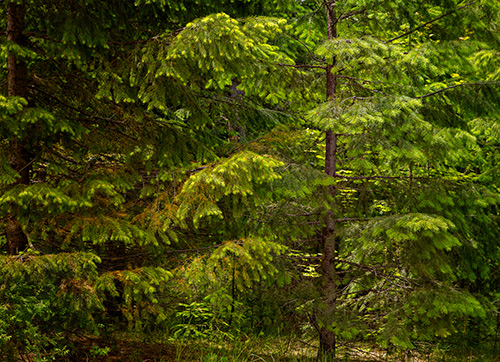
Trees
Just about anything can become interesting subject matter for a photographer. I was looking through images that I made on a family trip a while back, and came upon this one. I recall stopping to look at the river that was running swiftly over some rocks, but after stopping the car this tree caught my attention. The sun had gone behind some high clouds, softening the light, which is always a good thing. The leaves on a tree behind the pine tree here seemed to wrap around the trunk. I sat trying to figure out what it was that made the scene work and how to capture what I was feeling. I knew that the sun would soon return, so I made some quick decisions and this is what I came up with. I really like the new growth showing on the tips of the branches. The monochromatic color scheme always works for me as well. It is just a simple tree, but I like it. To me, simple is beautiful.
by tmoffett | Jul 26, 2012 | Black and White, Composition, Landscape, Photographic Philosophy, Photographic Technique
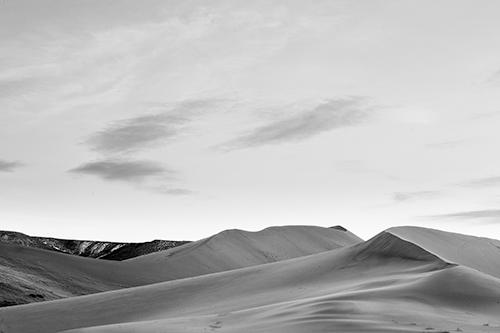
Bruneau Dunes
I was visiting with another photographer one day and we were talking about quality of light. I rise early and stay up late to photograph during the sweet light hours. This other photographer mentioned that you need the sweet light for color photography, but then switch to black and white during mid-day. I was very surprised to hear him say that and I one hundred percent disagree with him. Light quality is just that, quality. It really does not matter if you are shooting color or black and white. If you want quality light, you must work when the light is good. I have always taught my students that if you learn to shoot black and white, your color work will be much better, due to the fact that you must learn to see tones. Good tonal separation happens when the light is good. That is just another reason to photograph early and late.
The image above was made just as the sun was setting at Bruneau Dunes. The low sun is what is creating the highlight and shadows that sculpt the shape of the dunes. There is also balance between the dunes and the sky. None of this would have happened earlier in the day. For great landscape photography it is a must to photograph during the sweet light, otherwise you are just taking snapshots.
With the advent of digital photography, black and white photography is becoming a lost art. So many photographers just shoot a thousand images and then play with them on the computer to see what will look good as a monochrome image. It used to be, back in the days of film, that you would have to learn to see in black and white. We used filters to shift tones when we exposed the film, and then made additional adjustments in the development and printing stages to get the previsualized image on paper. Now we apply filters after the fact, and we get to watch the development in our “digital darkroom”… computer. It still seems so backward to me. Maybe I am just old school, but I believe that thinking before we press the shutter, like we used to do, will make us better photographers. Thinking more and shooting less is much more effective than the alternative. It will help put art back into our photographs.
by tmoffett | Jul 23, 2012 | Color, Composition, Critique, Landscape, Photographic Technique, Uncategorized
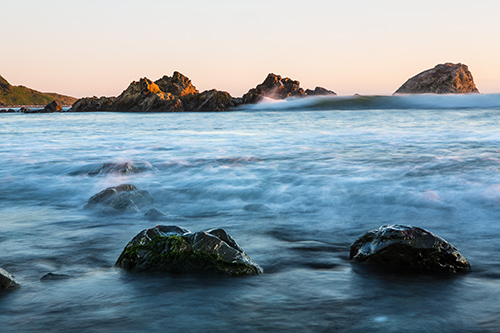
Ocean View, Crescent City, CA
I haven’t been out photographing for a few days and I am starting to get a bit antsy. I have been sitting in front of my computer getting some much needed work done, but I need to photograph. It doesn’t matter that I have a backlog of images to process and other tasks that need worked on, the need to make new images is always there. I guess that means I am a photographer. It is in my blood.
I pulled this image to post from my last trip to the coast. We were in Crescent City, California to photograph the Redwoods, but when I am close to the ocean, I will always find time to spend there. The evening I made this photograph, the sky was naked and colorless, so I really focused on the sea. One thing that I stress in my classes and workshops is to work the camera angles. Many times, especially at the ocean, I find photographers up on the beach, away from the water but shooting the water from a high angle. Not me. I like to be in the water. I try to find a lower angle to shoot from, as this will emphasize the foreground objects better. I have found that if I press my tripod down in the sand it becomes very stable. Unless a big wave slams into the tripod, it is remains quite stable in the water even at long shutter speeds. This image is a 1.3 second exposure, tripod legs buried under about 18 inches of water and waves hitting the tripod legs. The image is still tack sharp. When photographing this way you must keep an eye on the incoming waves, as occasionally a sleeper wave will come out of nowhere and you better be ready to move or risk soaking all of your gear. For this image, I actually wanted to get lower, but when I did, the incoming waves blocked the view of the rocky background too much.
One thing I really like about this image is not only the emphasis on the foreground rocks, but how the low angle also enlarges the size of the wave coming in. The wave creates a nice transition from ocean to rock in the background. I know it is hard to see in the small image here, but the water is packed with texture, detail and subtle color shifts, showing the warm light of the setting sun reflecting off of the highlights, but the deeper parts of the water remain a rich and vibrant blue. There is a lot of life in the finished print.
by tmoffett | Jul 19, 2012 | Black and White, Color, Composition, Photographic Technique
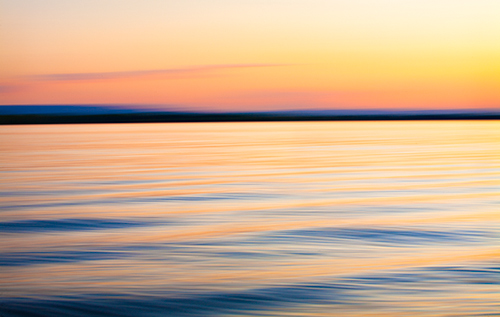
Complementary Reflections
It seems kind of strange to me to be talking about color. My photographic roots are in black and white. Before digital came into play, all of my personal work was black and white. I wouldn’t even carry color film with me. I loved what I could do with black and white. The entire process from shooting to processing to printing was fascinating to me. Expanding or compacting the tonal range of a scene and moving the tones to where I thought they should be was what I loved. I felt in complete control of the scene I was photographing. Then came digital.
The changes that digital brought along have been significant to me. I won’t go into them all now, that is for another time. The one change that I will discuss, though, is how it has affected my use of color. I still like to print in black and white, but I have added color as well to my repertoire.
Photographing in color first, and then converting the image to black and white, I began noticing how color could affect an image. I began studying the color composition of each of my photographs before converting them to black and white, and soon I began looking at the color in a scene and analyzing it before pressing the shutter. Little by little, color photographs began appearing in my portfolio. Now, it seems, that only those very special images make it to black and white.
The image above, Complementary Reflections, is one where color is everything. Without the color, the photograph would be a complete failure. The cool tones of the eastern sky reflecting in the water filled with the warm colors from the setting sun creates a feeling of excitement in the image that draws me in. When making this photograph, I got an idea to do a series of abstract images about color. Most of the photographs in the series so far I have made at the ocean, but occasionally I find just the right conditions on a lake or other body of water to photograph this way. It is fun and exciting to evolve and change. This change, to photograph in color, never would have happened for me if I had resisted the move to digital capture. It has been challenging at times, but always exciting!
This photograph also appears in my book Silent Solitude.
by tmoffett | Jul 17, 2012 | Color, Landscape, Photographic Philosophy
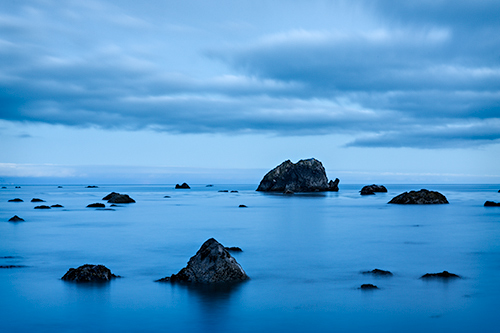
Still
The ocean, during the day is alive with activity. It is an exciting place to be. I love beachcombing with my kids collecting all kinds of interesting rocks and shells. Letting the waves crash into you and nearly knocking you down is a fun experience. Watching surfers catch the waves and riding them ashore, flying kites, tidepooling, and the list of activities goes on and on. When the sun sets, though, something magical happens. Everything seems to slow down, at least in my minds eye it does. The sounds become soothing, the fresh ocean breeze is calming to the soul. Yes, the waves of the rising tide are still crashing into the rock lined shore, but in my minds eye I see something entirely different. A long exposure smooths the surface of the wild sea and calms the waves crashing ashore. The cool blue sky bathes the scene in rich cool tones that create a very soothing effect on the viewer. This is what I come to the ocean for!
Previsualization, being able to recognize what it is I really see, and then being able to successfully render that image with the camera is what creative photography is about. Anyone can shoot a thousand images and then find a good one, but to be able to consistently render your feelings in an image is something entirely different. You must know your tools and understand how to use them if you are to create photographs that exhibit what your minds eye sees. It is not so much about what you physically see, but how you interpret what you see.
by tmoffett | Jul 9, 2012 | Color, Landscape, Photographic Philosophy
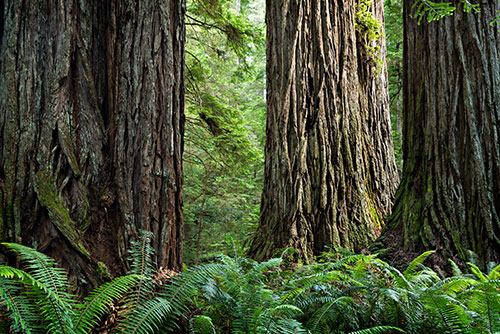
Grove of the Titans
A couple of weeks ago I was on a family trip to see the Redwoods, and as usual, I mixed in a little photography as I do with every trip. The first morning I was up before 5:00 AM to make sure I would capture the morning sweet light and headed up Howland Hill Road into the Jedediah Smith Redwoods State Park toward Stout Grove. One nice thing about being a photographer and getting up early is that you have the world to yourself. When I arrived at the grove, not another soul was around. It was just me and the trees. Peaceful and quiet, I was left to think, meditate and photograph. The experience was awesome, but that is not what I want to talk about today.
After some time of photographing, I heard footsteps behind me, and I turned around and met a wonderful man from New Jersey. He had done a lot of research on the redwoods, and clued me in to a couple of groves of trees that are a bit off the beaten path, and are quite hard to locate without help. Park rangers will not disclose their locations, as they hold some of the largest trees in the world. One of those groves is the Grove of the Titans, home to the 1st, 4th and 5th largest Coastal Redwoods in the world. These massive trees have bases up to nearly thirty feet in diameter. Ten feet is huge, but thirty? To me it was unimaginable. I decided to take my wife and kids with me later that day to locate the grove and then return in better light to photograph.
In the afternoon the five of us headed out on what turned out to be quite the adventure. The first mile or so was a breeze as we were on a well marked and maintained trail. Then the adventure. I knew that we needed to veer off the trail, and we quickly found ourselves bush whacking through dense ferns that were taller than me, although at my height, that is not too difficult! We climbed over downed trees covered in moss and unstable root systems where, if not extremely careful, we would find ourselves slipping and risking twisted ankles or worse. After some time, my youngest two children (13 and 8 years old) had had enough and felt we should turn back. My older son and I felt like we were on the verge of something exciting and move on while my wife turned back with the others. As they turned back, we surveyed the situation and determined that we needed to drop down into the small valley and cross the stream, which we did. As we climbed the bank on the other side…WOW! I have never seen such large trees.
As my son and I stood in the middle of this circular grove of giants, I was speechless. We both stood in silence for a minute, and then my son spoke, “Something happened here.” I was overwhelmed. It was as if we were on sacred ground. I have been in some pretty special places, and the feeling here rivaled the feeling I have had in those other places. I felt like I was in an ancient temple of sorts. I knew that I must come back and photograph, while at the same time I knew that I could in no way do justice to the scene in front of me.
The next morning I arose early again, and with my wife headed to the grove. We arrived, much more quickly this time, as we knew the location and found an easier way in. I sat in the center of the grove again and took it all in. This grove is a large open circle formed by 9 of the largest trees I have ever encountered. In the center is a small mound on which I stood. Again I was in awe of what nature presented me with. I set my camera on the tripod and began photographing, trying desperately to photograph what I felt. The massive tree trunks, tall and majestic, overpower anything and everything in their presence. The quiet, the peace, the beauty of it all leaves in my mind an assurance that there is a God, a Creator who is in control and wants me to enjoy His creations.
Again, as I left the grove, I felt like I was leaving sacred ground. There was a feeling difficult to portray in images. It was something that had to be experienced.












Recent Comments